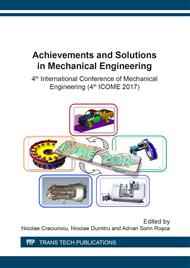p.248
p.256
p.262
p.267
p.273
p.279
p.285
p.291
p.297
Fiber Orientation of Composite Materials - Effect on Mechanical Properties
Abstract:
Fiber orientation is essential when we want to predict the behavior of a composite material, also for determining the mechanical properties of such materials. Many researches in this field showed that the orientation of fibers has a major role, for example, in increasing some properties, or decreasing others. Some of these studies are experimental, some are made using only the Finite Element Method (FEM).In this work, we present a numerical approach in order to estimate the influence of the collagen fibers orientation on the mechanical properties of the natural composite, which is human cortical bone. Based on the mathematical theory of homogenization, allowing computing all the elastic (but also piezo and dielectric) properties of a composite material, this study quantifies the main influence of the fibers orientation and its effect on the mechanical properties, but also on the influence of the cortical architecture on mechanical properties.
Info:
Periodical:
Pages:
273-278
Citation:
Online since:
March 2018
Authors:
Price:
Сopyright:
© 2018 Trans Tech Publications Ltd. All Rights Reserved
Share:
Citation:


